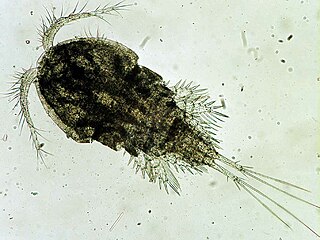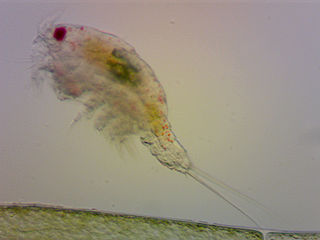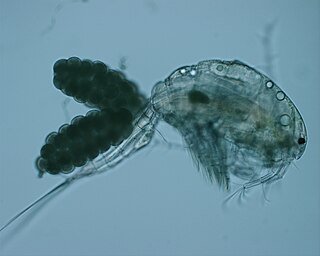
Cyclops is one of the most common genera of freshwater copepods, comprising over 400 species. Together with other similar-sized non-copepod fresh-water crustaceans, especially cladocera, they are commonly called water fleas. The name Cyclops comes from the Cyclops of Greek mythology, as they have a single large eye; in Cyclops, the eye may be either red or black.

Diaptomus is a genus of copepods with a single eye spot. It is superficially similar in size and appearance to Cyclops. However it has characteristically very long first antennae that exceed the body length. In addition, the females carry the eggs in a single sac rather than the twin sacs seen in Cyclops. It is a copepod of larger freshwater ponds, lakes and still waters.
Acanthocyclops is a genus of copepod crustaceans in the family Cyclopidae. It was originally described by Friedrich Kiefer as a subgenus of Cyclops, and contains the following species:
Arctodiaptomus is a genus of copepods in the family Diaptomidae.

Attheyella is a genus of copepods in the family Canthocamptidae, containing the following species:
Boeckella is a genus of copepods in the family Centropagidae.

Epischura is a genus of copepods in the family Temoridae.

Mesocyclops is a genus of copepod crustaceans in the family Cyclopidae. Because the various species of Mesocyclops are known to prey on mosquito larvae, it is used as a nontoxic and inexpensive form of biological mosquito control.
Metadiaptomus is a genus of crustacean in the family Diaptomidae, containing the following species:
Neutrodiaptomus is a genus of copepods in the family Diaptomidae. The Japanese endemic species N. formosus is listed as Data Deficient on the IUCN Red List. The genus Neutrodiaptomus contains the following species:
Notodiaptomus is a genus of copepods in the family Diaptomidae. It is the most widely distributed, most abundant and most species-rich genus of freshwater calanoid copepods in the Neotropics. The genus was erected in 1936 by Friedrich Kiefer for eleven species formerly placed in a wider Diaptomus. Notodiaptomus deitersi was chosen to be the type species by Raúl Adolfo Ringuelet in 1958.

Thermocyclops is a genus of crustacean in family Cyclopidae. It was first described and later extensively researched by Friedrich Kiefer, who discovered some 20 species. The species and subspecies of the genus inhabit fresh and brackish waters alike all around the world, although most are from tropical areas.
Tropodiaptomus is a genus of copepods in the family Diaptomidae. It includes the following species, many of which are narrow endemics and are included on the IUCN Red List :

Diaptomidae is a family of freshwater pelagic copepods. It includes around 50 genera:

The Cyclopidae are a family of copepods containing more than half of the 1,200 species in the order Cyclopoida in over 70 genera.
Halicyclops is a genus of copepods belonging to the family Cyclopidae. There are currently 94 described species found in brackish habitats throughout the world:
Microcyclops is a genus of copepods, containing the following species:

Eurytemora is a genus of copepods in the family Temoridae. The World Register of Marine Species lists the following species:
Heterocope is a genus of copepods in the family Temoridae. It was described by Norwegian biologist Georg Ossian Sars in 1863.

Leptodiaptomus is a genus of copepods belonging to the family Diaptomidae.










